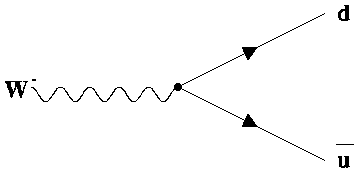How to Identify Events Containing a Pair of W Particles
The production of a
W+W-
pair of particles can be represented by the following diagrams:


After about
10-25
seconds a W decays, so we don't see it directly in our detector.
A W can decay in two different ways.
The first type of decay produces a lepton and an antineutrino.
For example, the following picture shows the W decaying to a muon and a muon
antineutrino.

In a similar way a W can to decay to produce an electron or a tau lepton.
The second type of W decay produces a quark and an antiquark:

Because both the
W+
and the
W-
decay to produce particles we see in the detector,
the resulting events are slightly more complicated than
the particle-antiparticle pair events we looked at in the previous section.
We get different types of
W+W-
event depending on whether both
W+
and
W-
decay to produce quarks, both decay to produce leptons,
or one W decays to produce quarks and one W decays to produce leptons.
Here are some examples of the different types of
W+W-
events:
- both W+ and W- decay to produce a quark
and an antiquark:
- both W+ and W- decay to produce a charged lepton
and a neutrino:
- one W decays to produce a charged lepton
and a neutrino, and the other W
decays to producea quark
and an antiquark:
Once you've understood the way we identify the different
types of events, proceed to:
 Challenge III
Challenge III
 Home Page
Home Page






 Challenge III
Challenge III